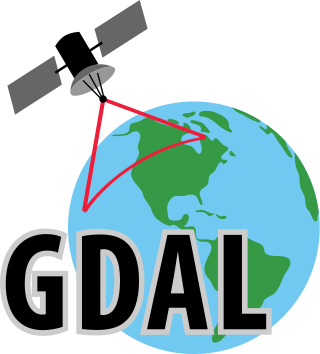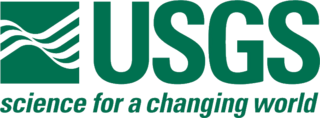
Environmental Systems Research Institute, Inc., doing business as Esri, is an American multinational geographic information system (GIS) software company headquartered in Redlands, California. It is best known for its ArcGIS products. With a 40% market share, Esri is the world's leading supplier of GIS software, web GIS and geodatabase management applications.
A GIS file format is a standard for encoding geographical information into a computer file, as a specialized type of file format for use in geographic information systems (GIS) and other geospatial applications. Since the 1970s, dozens of formats have been created based on various data models for various purposes. They have been created by government mapping agencies, GIS software vendors, standards bodies such as the Open Geospatial Consortium, informal user communities, and even individual developers.
A GIS software program is a computer program to support the use of a geographic information system, providing the ability to create, store, manage, query, analyze, and visualize geographic data, that is, data representing phenomena for which location is important. The GIS software industry encompasses a broad range of commercial and open-source products that provide some or all of these capabilities within various information technology architectures.

A virtual globe is a three-dimensional (3D) software model or representation of Earth or another world. A virtual globe provides the user with the ability to freely move around in the virtual environment by changing the viewing angle and position. Compared to a conventional globe, virtual globes have the additional capability of representing many different views of the surface of Earth. These views may be of geographical features, man-made features such as roads and buildings, or abstract representations of demographic quantities such as population.
A Web Map Service (WMS) is a standard protocol developed by the Open Geospatial Consortium in 1999 for serving georeferenced map images over the Internet. These images are typically produced by a map server from data provided by a GIS database.
ArcSDE is a server-software sub-system that aims to enable the usage of Relational Database Management Systems for spatial data. The spatial data may then be used as part of a geodatabase.

ArcGIS is a family of client, server and online geographic information system (GIS) software developed and maintained by Esri.

QGIS, also known as Quantum GIS, is a geographic information system (GIS) software that is free and open-source. QGIS supports Windows, macOS, and Linux. It supports viewing, editing, printing, and analysis of geospatial data.
The Open Source Geospatial Foundation (OSGeo), is a non-profit non-governmental organization whose mission is to support and promote the collaborative development of open geospatial technologies and data. The foundation was formed in February 2006 to provide financial, organizational and legal support to the broader Free and open-source geospatial community. It also serves as an independent legal entity to which community members can contribute code, funding and other resources.

The Geospatial Data Abstraction Library (GDAL) is a computer software library for reading and writing raster and vector geospatial data formats, and is released under the permissive X/MIT style free software license by the Open Source Geospatial Foundation. As a library, it presents a single abstract data model to the calling application for all supported formats. It may also be built with a variety of useful command line interface utilities for data translation and processing. Projections and transformations are supported by the PROJ library.
In cartography and geographic information systems, rubbersheeting is a form of coordinate transformation that warps a vector dataset to match a known geographic space. This is most commonly needed when a dataset has systematic positional error, such as one digitized from a historical map of low accuracy. The mathematics and procedure are very similar to the georeferencing of raster images, and this term is occasionally used for that process as well, but image georegistration is an unambiguous term for the raster process.
Geospatial metadata is a type of metadata applicable to geographic data and information. Such objects may be stored in a geographic information system (GIS) or may simply be documents, data-sets, images or other objects, services, or related items that exist in some other native environment but whose features may be appropriate to describe in a (geographic) metadata catalog.
Cadcorp Limited is a British owned and run company established in 1991. Cadcorp has its headquarters in Stevenage, Hertfordshire, U.K. Cadcorp has a network of distributors and value added resellers (VARs) around the world.
Hexagon Geospatial's GeoMedia Professional is a geographic information system (GIS) management solution for map generation and the analysis of geographic information with smart tools that capture and edit spatial data. GeoMedia is used for: creating geographic data; managing geospatial databases; joining business data, location intelligence and geographic data together; creating hard and soft-copy maps; conduct analysis in 'real-time'; base platform for multiple applications, geographic data validation, publishing geospatial information and analyzing mapped information.

A Digital Line Graph (DLG) is a cartographic map feature represented in digital vector form that is distributed by the U.S. Geological Survey (USGS). DLGs are collected from USGS maps and are distributed in large, intermediate and small scale with up to nine different categories of features, depending on the scale. They come in optional and Spatial Data Transfer Standard (SDTS) format and are topologically structured for use in mapping and geographic information system (GIS) applications.
Global Mapper is a geographic information system (GIS) software package currently developed by Blue Marble Geographics that runs on Microsoft Windows. The GIS software competes with ESRI, GeoMedia, Manifold System, and MapInfo GIS products. Global Mapper handles both vector, raster, and elevation data, and provides viewing, conversion, and other general GIS features. Global Mapper has an active user community with a mailing list and online forums.

Whitebox Geospatial Analysis Tools (GAT) is an open-source and cross-platform Geographic information system (GIS) and remote sensing software package that is distributed under the GNU General Public License. It has been developed by the members of the University of Guelph Centre for Hydrogeomatics and is intended for geospatial analysis and data visualization in research and education settings. The Whitebox GAT project started as a replacement for the Terrain Analysis System (TAS), a geospatial analysis software package written by John Lindsay. The current release supports raster and vector (shapefile) data structures. There is also extensive functionality for processing laser scanner (LiDAR) data containing LAS files.
Geographic information systems (GIS) play a constantly evolving role in geospatial intelligence (GEOINT) and United States national security. These technologies allow a user to efficiently manage, analyze, and produce geospatial data, to combine GEOINT with other forms of intelligence collection, and to perform highly developed analysis and visual production of geospatial data. Therefore, GIS produces up-to-date and more reliable GEOINT to reduce uncertainty for a decisionmaker. Since GIS programs are Web-enabled, a user can constantly work with a decision maker to solve their GEOINT and national security related problems from anywhere in the world. There are many types of GIS software used in GEOINT and national security, such as Google Earth, ERDAS IMAGINE, GeoNetwork opensource, and Esri ArcGIS.
SuperMap is a Geographic Information System (GIS) software products and services provider and IT enterprise in Asia. The headquarters are in Beijing, China. The company was founded in 1997. It has over 20 branch offices in China and one office in Tokyo, Japan. SuperMap has developed many agencies and partners all over the world including South Korea and Malaysia. In 2009, SuperMap was listed in Shenzhen Stock Exchange of China (300036.SZ). In 2018 revenues were about $200 million. In 2015, SuperMap occupied 31.6% of Chinese GIS market share, listed as number 1 of Chinese market share. According to the Geographic Information Systems Market Research Study Report 2019 released by ARC Advisory Group, SuperMap has the 3rd largest share in global GIS market, and the 1st largest share in Asia GIS market.
DAT/EM Systems International is an Alaska-based company that develops digital photogrammetric mapping applications to extract and edit 3D vector terrain and object features from stereo imagery and point clouds. DAT/EM Systems International develops solutions for the photogrammetry, engineering & GIS industries.






